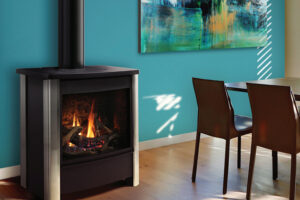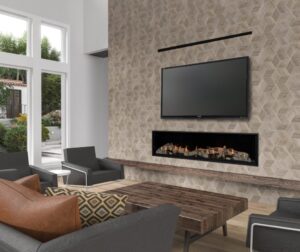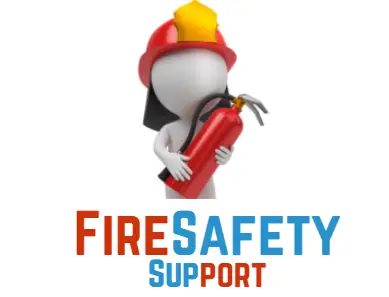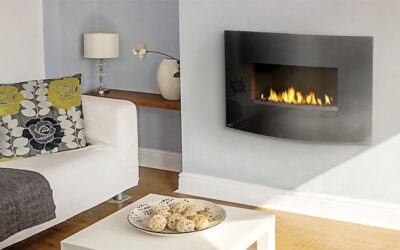Are you considering adding a gas fireplace to your home? Does a gas fireplace need to be vented? One important aspect to consider is whether or not it needs to be vented. The answer may surprise you. Read on to learn more about the ventilation requirements for gas fireplaces and how they can impact your home.
Yes, a gas fireplace typically needs to be vented. This is because gas fireplaces produce combustion gases, such as carbon monoxide, that need to be safely expelled from the home. Proper ventilation also helps to prevent the build-up of moisture and improve the overall efficiency of the fireplace.
There are several different ventilation options available for gas fireplaces, including direct vent, natural vent, and vent-free models. It is important to consult with a professional to determine the best ventilation solution for your specific fireplace and home.
What is a gas fireplace, and how does it work?

A gas fireplace is a type of home heating appliance that uses natural gas or propane as a fuel source. It is designed to mimic the look and feel of a traditional wood-burning fireplace but with the convenience of being able to turn it on and off with the flip of a switch.
To use a gas fireplace, the gas supply is turned on, and the pilot light is ignited. The pilot light is a small flame that remains burning at all times and is used to ignite the main burner when the fireplace is turned on.
When the main burner is ignited, the gas flows through the burner and is mixed with air to create a flame. The flame is then contained within a sealed combustion chamber, which helps to prevent the release of harmful gases into the home.
Gas fireplace venting requirements
The venting requirements for a gas fireplace will vary depending on the specific model and type of gas fireplace being used, as well as local building codes and regulations. In general, gas fireplaces need to be vented to the outside of the home through a chimney or flue or through a vent pipe that is installed through an exterior wall.
The venting system should be properly sized and installed to ensure that it can effectively remove the combustion byproducts produced by the gas fireplace.
In addition to proper ventilation, gas fireplaces also need to have a reliable source of fuel, such as natural gas or propane, and may require additional equipment, such as a gas line or gas shut-off valve, to operate safely.
It is important to follow the manufacturer’s instructions and local building codes when installing and using a gas fireplace to ensure that it is safely and properly vented and operated.
Disadvantages of ventless gas fireplace
Ventless gas fireplaces have several potential disadvantages that you should consider before deciding whether to install one in your home.
Some of the main disadvantages include the following:
1. Potential safety concerns: Ventless gas fireplaces do not vent to the outside, which means that the gases produced during combustion, such as carbon monoxide and water vapor, are released into the room.
While ventless gas fireplaces are designed to burn cleanly and efficiently, there is a risk of carbon monoxide poisoning if the fireplace is not properly installed or maintained. It is important to have a ventless gas fireplace inspected and serviced regularly to ensure that it is operating safely.
2. Limited installation options: Ventless gas fireplaces can only be installed in certain locations, such as on an interior wall or in the corner of a room. They cannot be installed in a bedroom or other sleeping area, and they must be located a certain distance from windows and doors.
3. Possible negative health effects: Some people may experience negative health effects when using a ventless gas fireplace, such as headaches, dizziness, or respiratory problems. This is due to the release of combustion byproducts into the air. If you or anyone in your household has sensitive respiratory issues, a ventless gas fireplace may not be the best choice.
4. Limited design options: Ventless gas fireplaces typically have a more limited range of design options compared to vented gas fireplaces, as they do not require a chimney or flue. This means that you may have fewer options for customizing the appearance of your fireplace.
5. Potential for moisture buildup: Because ventless gas fireplaces do not vent to the outside, they can increase the humidity level in a room. This can lead to moisture buildup on windows and other surfaces, which can be a problem if you live in a humid climate.
Is a gas fireplace more efficient than a wood fireplace?

Gas fireplaces can be more efficient than wood fireplaces in several ways. One reason is that gas fireplaces do not require the same level of maintenance as wood fireplaces. You do not need to chop or purchase wood, and you do not need to clean out ashes.
In terms of energy efficiency, gas fireplaces can be more efficient than wood fireplaces if they are properly installed and maintained. Gas fireplaces do not produce as much particulate matter as wood fireplaces, which means that they do not contribute as much to air pollution.
Also gas fireplaces also tend to have higher efficiency ratings than wood fireplaces, meaning that they convert more of the energy they use into heat.
However, it is important to note that the efficiency of a gas fireplace can vary depending on the model and how it is used. Some gas fireplaces may be less efficient than others, and using a gas fireplace with the doors open can reduce its efficiency.
Additionally, the overall efficiency of a gas fireplace may be affected by factors such as the age of the unit and how well it is sealed and insulated.
Can a gas fireplace be installed in an existing home?
Yes, it is possible to install a gas fireplace in an existing home. However, there are a few considerations to keep in mind.
First, you will need to determine if your home has a gas line available for the fireplace. If not, you will need to have a gas line installed by a licensed professional.
Next, you will need to choose a location for the fireplace. It is important to consider the location of the gas line and the venting system, as well as the layout of your home and any local building codes.
Once you have determined the location and have the necessary gas and venting systems in place, you can hire a licensed professional to install the fireplace. It is important to follow all manufacturer’s instructions and local building codes when installing a gas fireplace to ensure it is safe and properly functioning.
Do gas fireplaces require a chimney or venting system?
Yes, gas fireplaces typically require a chimney or venting system to safely vent the exhaust gases and byproducts of combustion produced by the fireplace. The specific type of venting system required for a gas fireplace will depend on the design and configuration of the fireplace and the local building codes and regulations in your area.
Some gas fireplaces may be designed to be vented directly through an exterior wall using a special venting system, while others may require a traditional chimney. It is important to follow the manufacturer’s instructions and local building codes when installing a gas fireplace to ensure that it is installed properly and safely.
How do I vent a gas fireplace?
To vent a gas fireplace, you will need to install a chimney or flue that will allow the byproducts of the combustion process to be safely released outside of your home. The type of venting system you choose will depend on the location and configuration of your fireplace, as well as local building codes and regulations.
Here are the steps for venting a gas fireplace:
1. Consult with a professional: Before you begin the installation process, it is important to consult with a licensed contractor or professional who is familiar with local building codes and can help ensure that the installation is done safely and correctly.
2. Choose a venting system: There are several options for venting a gas fireplace, including a traditional chimney, a direct vent system, or a power vent system. Your professional can help you determine the best option for your specific needs and installation.
3. Install the venting system: Once you have chosen the appropriate venting system, you will need to install it according to the manufacturer’s instructions. This may involve cutting holes in your wall or roof and installing the appropriate pipe or chimney.
4. Connect the gas line: Once the venting system is installed, you will need to connect the gas line to your fireplace. This will typically involve installing a gas valve and connecting the gas line to the valve using the appropriate fittings.
5. Test and use the fireplace: Once everything is installed and connected, you should test the fireplace to ensure that it is working properly. Follow the manufacturer’s instructions for lighting and using the fireplace, and make sure to have the fireplace inspected by a professional on an annual basis to ensure that it is safe to use.
It is important to note that venting a gas fireplace requires careful attention to detail and a thorough understanding of local building codes and regulations. If you are not comfortable with this process, it is best to hire a professional to handle the installation.
Can a gas fireplace be vented through a wall or ceiling?

Yes, it is possible to vent a gas fireplace through a wall or ceiling. Most gas fireplaces are designed to be vented through an external wall or through the roof of a building.
The specific requirements for venting a gas fireplace through a wall or ceiling will depend on the type of fireplace you have, as well as local building codes and regulations. It is important to follow the manufacturer’s instructions and consult with a professional when installing a gas fireplace to ensure that it is properly ventilated.
What are the benefits of venting a gas fireplace?
There are several benefits to venting a gas fireplace:
1. Improved safety: Venting a gas fireplace allows harmful gases, such as carbon monoxide, to be safely released outside rather than accumulating in the room. This helps to prevent the risk of carbon monoxide poisoning.
2. Increased efficiency: Venting a gas fireplace allows the fireplace to draw in outside air for combustion, which can improve the efficiency of the fireplace. This means that the fireplace will burn fuel more efficiently, resulting in lower energy costs.
3. Improved indoor air quality: Venting a gas fireplace helps to remove pollutants and other contaminants from the indoor air, which can improve the overall air quality in the home.
4. Reduced moisture buildup: Venting a gas fireplace helps to reduce moisture buildup in the home, which can prevent the growth of mold and mildew.
5. Enhanced appearance: Venting a gas fireplace can also improve the appearance of the fireplace by allowing the flames to be more visible. This can create a more attractive and realistic appearance for the fireplace.
Overall, venting a gas fireplace can provide a number of benefits related to safety, efficiency, indoor air quality, and appearance.
Are there any safety considerations for venting a gas fireplace?
Yes, there are several safety considerations to keep in mind when venting a gas fireplace:
Make sure the venting system is properly installed: It is important to have a professional install the venting system to ensure it is properly installed and functioning correctly.
This will help to prevent any potential issues or accidents:
1. Follow the manufacturer’s instructions: It is important to follow the manufacturer’s instructions for the gas fireplace and venting system to ensure that it is used safely. This includes using the proper venting materials and following any maintenance recommendations.
2. Inspect the venting system regularly: Regular inspection of the venting system is important to ensure it is functioning properly and identify any potential issues that may need to be addressed.
3. Use the fireplace responsibly: It is important to use the fireplace responsibly by following all safety guidelines and only using it as intended. This includes not blocking the vents or allowing objects to come into contact with the fireplace or venting system.
By following these safety considerations, you can help ensure that your gas fireplace and venting system are used safely and effectively.
How do I maintain and clean the venting system for a gas fireplace?
It is important to regularly maintain and clean the venting system for your gas fireplace to ensure it is functioning properly and safely.
Here are some steps you can follow in cleaning and maintaining the venting system:
- Turn off the gas supply to the fireplace.
- Remove any debris or obstruction from the venting system, including the chimney, flue, and vents. Use a flashlight to inspect the system and a brush or vacuum to remove any debris.
- Check the seals on the venting system for cracks or leaks. If you find any, they should be repaired as soon as possible.
- Inspect the venting system for signs of corrosion, such as rust or discoloration. If you find any, it may be necessary to have the system professionally cleaned or repaired.
- Make sure that the venting system is properly sized for your fireplace. A system that is too small can lead to a build-up of carbon monoxide, while a system that is too large can lead to inefficient operation.
- Follow the manufacturer’s recommendations for cleaning and maintaining your specific venting system.
It is generally recommended to have your venting system professionally inspected and cleaned every year. This will ensure that it is functioning properly and safely and can help extend the life of your gas fireplace.
Recommended:
Can a gas fireplace be converted to a wood-burning fireplace or vice versa?
Yes, it is possible to convert a gas fireplace to a wood-burning fireplace or vice versa. However, it is important to note that this type of conversion can be a complex and costly process. It typically requires the services of a professional, such as a licensed contractor or a chimney sweep, to properly assess the feasibility of the conversion and perform the necessary work.
If you are considering converting a gas fireplace to a wood-burning fireplace, the process may involve removing the gas components, installing a new chimney or flue, and installing a wood-burning fireplace insert or a freestanding wood stove. The specific steps and materials required will depend on the existing fireplace and the type of wood-burning fireplace or stove you are installing.
On the other hand, if you are considering converting a wood-burning fireplace to a gas fireplace, the process may involve removing the wood-burning components, installing a new gas line, and installing a gas fireplace insert or a freestanding gas stove. As with the other conversion, the specific steps and materials required will depend on the existing fireplace and the type of gas fireplace or stove you are installing.
It is important to note that both types of conversions may also require modifications to the surrounding structure and may require building permits. It is recommended to consult with a professional and carefully consider the costs and benefits of the conversion before proceeding.
Conclusion
This page answers the question does a gas fireplace need to be vented? A gas fireplace does need to be vented. Gas fireplaces produce byproducts of combustion, such as carbon monoxide and water vapor, that need to be safely expelled from the home.
Venting is also necessary to allow for proper airflow and to prevent the buildup of harmful gases inside the home. There are several types of venting systems that can be used for gas fireplaces, including direct vent, natural vent, and power vent systems.
It is important to consult with a professional and follow local building codes when installing a gas fireplace to ensure proper ventilation and safety.

